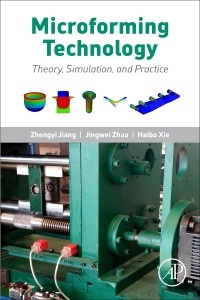Description
Microforming Technology
Theory, Simulation and Practice
Authors: Jiang Zhengyi, Zhao Jingwei, Xie Haibo
Language: English
Subjects for Microforming Technology:
Keywords
Asymmetrical rolling; Boundary conditions; Characteristic ratio; Composite model; Constitutive equation; Constitutive model; Copper; Counter pressure; Couple stress theory; Cross section; Crystal plastic deformation; Crystal plasticity theory; Crystallographic plane; Cup quality; Deformation texture; Density size effects; Design and manufacture; Dirichlet tessellation; Dislocations; Dynamics; Earing; Electricity; Electromagnetic force; Electron backscatter diffraction (EBSD); Electrostatic force; Finite element method; Finite element model; Finite element simulation; Flow stress; Foil; Foil rolling; Forming limit; Friction; Friction behavior; Friction size effects; Geometry; Grain heterogeneity; Grain shape; Grain size; Grain size effects; Heat transfer; Heating temperature; Higher-order stress; Hydrodynamics; Laser beam; Laser heating; Laser power; Length scale; Lubrication; Material heterogeneity; Mechanical properties; Mechanics; Mechanism-based theory; Mesoscopic model; Micro V-Bending; Micro bending; Micro compression; Micro compression machine; Micro cross wedge rolling; Micro cross wedge rolling (MCWR); Micro deep drawing; Micro deep drawing (MDD); Micro flexible rolling; Micro hydromechanical deep drawing; Micro hydromechanical deep drawing (MHDD); Micro sheet; Micro tensile test; Micro ultrathin strip; Micro ultrathin strip rolling; Microforming; Microforming concept; Microforming system; Microstructural refinement; Microstructure; Microstructure size effects; Numerical integration; Oil-film thickness; One-stroke forming; Oxidation; Phenomenological theory; Phosphor bronze foil; Plasticity theory; Polycrystal model; Rate dependent theory; Rate independent theory; Recrystallization texture; Roll flattening; Roll gap; Rolling limit; Scaling laws; Shape size effects; Simulation; Simulation models; Size effects; Springback; Stainless steel; Strain gradient; Stress scatter; Surface asperity; Surface layer model
120.27 €
In Print (Delivery period: 14 days).
Add to cartSupport: Print on demand
Description
/li>Contents
/li>Readership
/li>Biography
/li>Comment
/li>
Microforming Technology: Theory, Simulation and Practice addresses all aspects of micromanufacturing technology, presenting detailed technical information and the latest research developments.
The book covers fundamentals, theory, simulation models, equipment and tools design, practical micromanufacturing procedures, and micromanufacturing-related supporting systems, such as laser heating system, hydraulic system and quality evaluation systems. Newly developed technology, including micro wedge rolling, micro flexible rolling and micro hydromechanical deep drawing, as well as traditional methods, such as micro deep drawing, micro bending and micro ultrathin strip rolling, are discussed.
This will be a highly valuable resource for those involved in the use, study and design of micro products and micromanufacturing technologies, including engineers, scientists, academics and graduate students.
Part I: Introductory Overview1. Fundamentals of Microforming2. Size Effects in Microforming
Part II: Theory of Microforming3. Scaling Laws4. Strain Gradient Plasticity Theory5. Crystal Plasticity Theory
Part III: Simulation of Microforming Process6. Simulation Models in Microforming7. Simulation of Micro Cross Wedge Rolling8. Simulation of Micro Flexible Rolling9. Simulation of Micro Ultrathin Strip Rolling10. Simulation of Micro Deep Drawing11. Simulation of Micro Hydromechanical Deep Drawing12. Simulation of Micro Bending13. Simulation of Micro Compression
Part IV: Practice of Microforming14. Practice of Micro Cross Wedge Rolling15. Practice of Micro Flexible Rolling16. Practice of Micro Ultrathin Strip Rolling17. Practice of Micro Deep Drawing18. Practice of Micro Hydromechanical Deep Drawing19. Practice of Micro Bending20. Practice of Micro Compression
Jingwei Zhao is a Research Fellow and supervisor of PhD students at the University of Wollongong, Australia, in the area of materials processing and manufacturing engineering. His main research interests include microforming and micromanufacturing of metallic materials, metal rolling technology, numerical modelling of manufacturing process, and tribology and mechanics in materials manufacturing. He has gained research experience in the field of materials processing and manufacturing engineering in work and study at universities in Australia, South Korea and China, and has been very actively involved in the manufacturing of many kinds of metal alloys. As a Chief Investigator, Zhao was awarded one ARC Discovery Project (2015-2017) in micromanufacturing. He has published 1 monograph, 2 edited books, 2 book chapters and over 100 research articles.
Haibo Xie is an Associate Research Fellow at the Uni
- Provides an accessible introduction to the fundamental theories of microforming, size effects, and scaling laws
- Includes explanations of the procedures, equipment, and tools for all common microforming technologies
- Explains the numerical modeling procedures for 7 different types of microforming
These books may interest you

Micromanufacturing Processes 184.47 €

Micromanufacturing Processes 71.13 €


